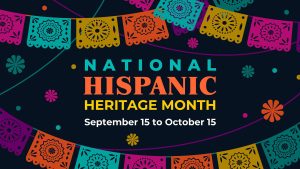
October has its fair share of celebrations and holidays, such as Indigenous Peoples’ Day and Halloween, but it still manages to make room to celebrate another important event: Hispanic Heritage Month.
The celebration was first observed in the United States in 1968 by President Lyndon B. Johnson and was later extended to 30 days by Ronald Reagan in 1988. Lasting from Sept. 15 to Oct. 15, Americans celebrate and commemorate its cultural, historical and social significance through various traditions, homages and events.
Freshman Charity Gosnell, a music education major, is part of the Hispanic community, and she views Frida Kahlo, a Mexican painter, as a Hispanic figure she looks up to.
“She was a painter and didn’t care about her appearance, which I thought was really cool,” Gosnell said. “If you look at portraits of her, you’ll see her eyebrows are really overgrown, and it went against standards that she didn’t want to live up to.”
With an estimated 62.5 million Hispanic people living in the United States, roughly 93,000 reside in Mississippi. Unfortunately, due to that small population, several people who live in Mississippi are not educated by their school system on the importance of Hispanic Heritage Month.
Senior Sara Cantú, a political science major and a member of the Hispanic community, described where she received her education in Hispanic culture.
“I graduated with five other Hispanic students in my high school,” Cantú said. “All of my knowledge of Hispanic culture comes from my parents and sisters, who are from Mexico. It’s never been anything that’s been relevant in my education.”
Sophomore Jacob Bandock, a social work major, also believes there’s a lack of attention given to Hispanic culture in the education system.
“It’s definitely overlooked,” Bandock said. “Unless you’re taking a Spanish class, you’re not learning about Hispanic Heritage Month.”
Several people in the Hispanic community also face discrimination and prejudice solely on their ethnicity, which has led to uncomfortable experiences they continue to deal with. Cantú has experienced several of these instances.
“I’ve become so desensitized to these situations where I would hear several jokes and microaggressions,”Cantú said. “And I would just brush it off and say ‘whatever’ to it.”
Bandock is also aware of the prejudice Hispanics face and how it is a current problem in today’s age.
“You have a sector of the population that’s not too keen on America becoming not so white,” Bandock said. “And with Hispanics being the largest growing minority group in America, that’s one of their main target hosts.”
Ole Miss, however, has been pushing to celebrate and embrace the importance of Hispanic culture. Organizations such as the Latin American Student Organization help promote and create events that welcome several students in the Hispanic community.
Cantú, a committed member of LASO, described her time in the club as a chance to meet more people in her demographic.
“I’ve been exposed to more people who are more embracing of their ethnicity as a Hispanic,” Cantú said. “Being around people like them definitely brought me out of my shell, and I feel that I’ve been around the right Mexican American students.”
One of the most notable events that celebrated Hispanic Heritage Month was the Latin Party hosted by LASO on Sept. 16. The party featured a barrage of dances, Hispanic songs and drinks, and students spending hours dancing with their friends and enjoying their time.
Sophomore Xavier Black, an international studies major, attended the party and enjoyed the music as well as the people he talked to.
“I came in there with an open mind, and I’ve heard so much great music that I’ve never heard before. Once any song came on, the party would immediately liven back up automatically and exhibit this contagious vibe that kept me on the dance floor,” Black said.
Ole Miss also hosted another event,“Fantastic Fabric-ations: Hispanic & Latinx Heritage Celebration,” which was set in the UM Museum and featured a display of impressive Hispanic and Latinx art.
Events such as these bring students together to remind them of multicultural events that are displayed on campus. Thanks to the dedicated commitment to celebrating Hispanic Heritage Month, people of all demographics can come together to create an equal welcome for everyone enrolled in the university.
“(Cultural events) encourage integration through the display of one’s culture,” Black said. “Once you figure something out about it, you can potentially find a similarity with your own and go from there because you feel more comfortable.”

























